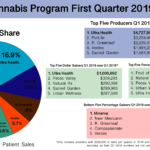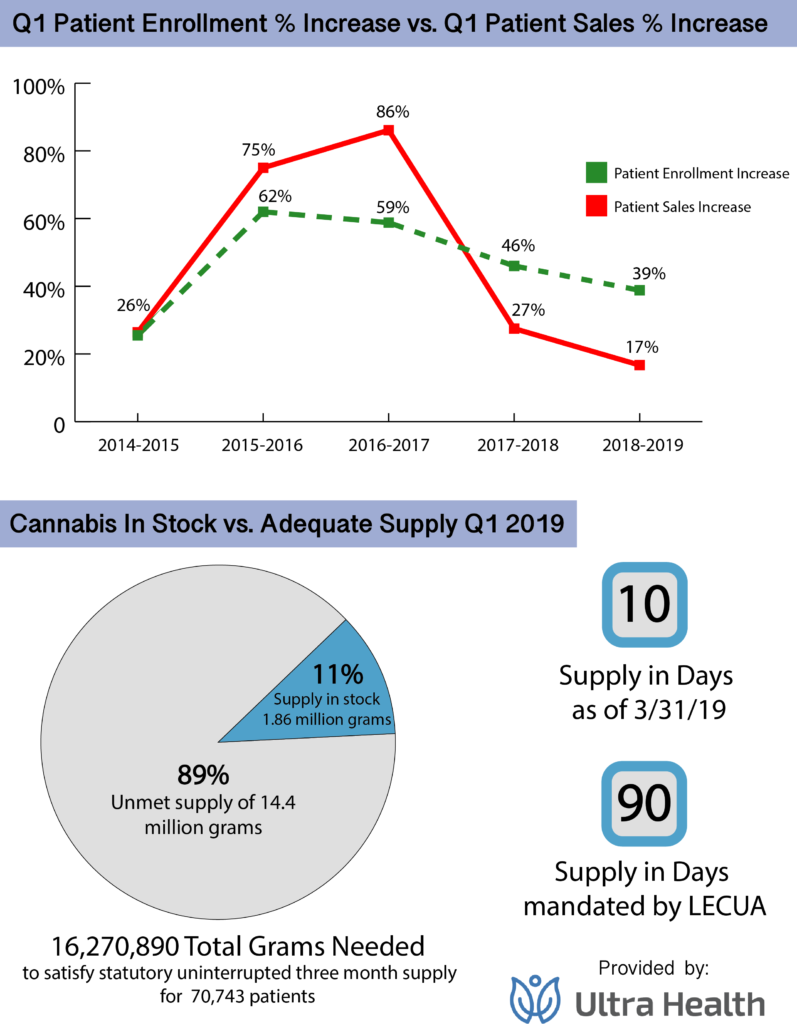
Enrollment gains dramatically outpace sales indicating illicit market activity, public health risks
(Albuquerque) – The New Mexico Medical Cannabis Program patient revenues from the first quarter of 2019 reached $28 million, representing a 16% increase over the first quarter of 2018. Patient enrollment from March 2018 to March 2019 increased by 39%, more than double the rate of patient sales over the same period, according to data published by the New Mexico Department of Health (NMDOH).
Historically, the Medical Cannabis Program has seen patient sales grow at the same pace or faster pace than enrollment year over year. From 2017 to 2018, however, patient sales began to dip below the growth rate of patient enrollment. Today, patient sales are lagging the furthest behind patient enrollment in the program’s 11-year history.
The significant gap between patient enrollment and patient sales can be attributed to program restrictions such as insufficient plant count regulations, scant purchase limits, and the disallowance of volume discounts for medical cannabis patients.
While 72,365 New Mexicans are seeking to improve their health conditions with medical cannabis, the poorly-managed regulated system is forcing otherwise legal participants to seek alternatives, such as the illicit and gray markets, for their needs. Forcing patients to enter the black market for their medical cannabis needs poses public safety hazards including theft, violence, criminal prosecution for cardholders, and health risks for patients with compromised immune systems.
Former DOH Secretary Lynn Gallagher stated in a bench trial testimony in 2017 that the goal of the program is to promote the purchase of cannabis from licensed producers, where product is tested, rather than the black market.While this was the program’s confirmed goal, the former administration’s overly-restrictive regulations on commercial producers proved NMDOH had no true commitment to reducing leakage into the black market.
Under Governor Michelle Lujan Grisham’s administration, it is likely the NMDOH will address the program restrictions which have induced more illicit marijuana activity in New Mexico. Department Secretary Kathyleen Kunkel indicated in a letter the department will be addressing the scant purchase limit regulations in the Emergency Rulemaking process over plant count.
“Double-digit, consistent growth in patient enrollment is the only guarantee in New Mexico’s medical cannabis program,” said Duke Rodriguez, CEO and President of Ultra Health®. “The signing of Senate Bill 406 and the Emergency Rulemaking process has certainly produced the most pivotal point in the program’s history. Now, the new administration has an incredible duty and responsibility to rectify the program’s inefficiencies, as dysfunctions of the regulated system will only be exacerbated with the legalization of cannabis for adult use.”
FIRST QUARTER PROVIDER BREAKDOWN
The top five providers accounted for nearly half of all patient sales and reported the following first quarter patient revenues:
- Ultra Health – $4,727,507
- PurLife – $3,254,507
- R. Greenleaf – $2,235,571
- Verdes – $1,891,295
- Sacred Garden – $1,581,905
The next five providers accounted for an additional 20 percent in patient sales, with the top ten providers accounting for nearly 70 percent of total first quarter retail revenues.
For the quarter, retail sales averaged $824,775 per producer and the median was $334,051. Five licensed producers reported no retail sales in the first quarter of 2019 but some wholesale activity was reported. There remains 34 active licensed producers as one license has been revoked.
Ultra Health led all wholesale purchasers spending nearly $1 million and buying 132,457 grams for the quarter. Wholesale revenues are not counted in patient sales to avoid duplicate reporting.
CONTINUED SHORTFALL OF AVAILABLE MEDICINE
By the end of the first quarter, the Medical Cannabis Program’s supply levels were significantly below statutory requirements. While the definition of adequate supply in the Lynn and Erin Compassionate Use Act mandates the uninterrupted availability of cannabis for a period of three months, patients only had a 10-day supply of medical cannabis at March 31, 2019.
There were only 1,863,730 grams in stock at the end of the quarter for 70,743 patients. If the program were to provide the statutory requirement of enough cannabis to meet patient purchase limits for a period of three months, on-hand supply would need to exceed 16 million grams.
The already prominent gap between patient demand and adequate supply will continue to widen, as the updated Lynn and Erin Compassionate Use Act signed by Gov. Lujan Grisham will take effect June 14, 2019.
Based on several program enhancements including access to medical cannabis for out-of-state participants, demand forecasts indicate a minimum of 5,000 mature plants per producer will be needed to provide an adequate supply of medical cannabis statewide.
The updated law allows school children to be administered medical cannabis while on school-grounds, adds workplace protections for patients, extends the lifetime of patient registry cards to three years and maintains that medical cannabis cards remain free for patients.
Other new additions to the law include guidance for medical cannabis consumption areas, removal of potency caps, continued enrollment via telemedicine, patient eligibility for anatomical gifting, and access to medical cannabis for those who are under supervision or in custody of a state or local government.


